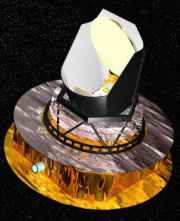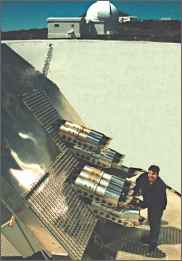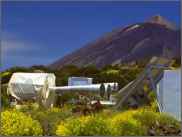
|
Observing the Big Bang |
|
The Cosmic Microwave Background (CMB) radiation originated approximately 300,000 years after the Big Bang when the Universe had expanded and cooled sufficiently to allow atoms to form and radio waves to travel unhindered through space. As the Universe has continued to expand, the wavelength of the radiation has stretched by a corresponding amount and is now detected mainly in the short (mm) wavelength radio region of the spectrum. Structure in the CMB The cosmic microwave background appears to be very uniform, roughly to one part in 100,000, but it must have contained small irregularities relating to density variations that would eventually lead to the formation of galaxies. Though the CMB was first detected in 1965, it is only since 1990 that it has been possible to map the very small irregularities, first detected by the COBE satellite, that are present. The way in which these irregularities vary as a function of angular scale is closely linked to the evolution of the Universe. CMB observations therefore provide a critical test of different theories of the Universe. The Very Small Array (VSA) The VSA (left) is a collaborative project between the University of Cambridge, Jodrell Bank Observatory, and the Instituto de Astrophysica de Canarias in Tenerife. The 14 small "horn" telescopes operate at wavelengths of between 8 and 11 mm, and their amplifiers are cooled to 15 degrees above absolute zero to provide the highest possible sensitivity. Together they form a small "aperture synthesis" array. Unlike the previous CMB receivers on Tenerife, which relied on the Earth's rotation to scan a strip of the sky (left), the horns are steerable and will track a point on the sky for several hours at a time. Following commissioning in 2000, a five year observing program will map the CMB fluctuations over much of the sky. The Planck Surveyor Spacecraft This, the foremost initiative for CMB observations in the new Millennium, is planned for launch in 2007 (left). Jodrell Bank engineers are building 30 and 44 GHz (10 and 7 mm wavelength) receivers for the mission, which will provide multi-frequency maps of the CMB over a wide range of angular scales. It is expected to determine the fundamental cosmological parameters to an accuracy of 1%.
|



